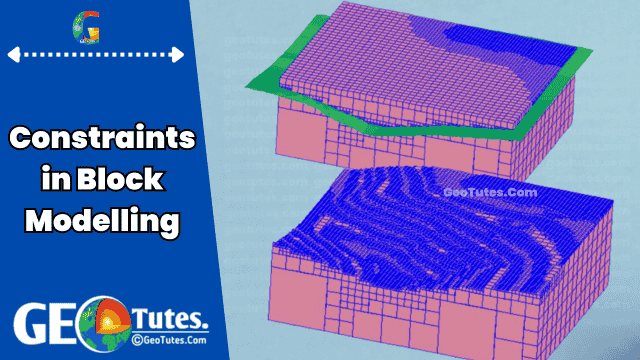Constraints in Block Modelling in the Context of Surpac play a crucial role in mining and geological modeling, allowing users to filter, analyze, and manipulate block models efficiently. By applying constraints, users can define specific conditions to extract meaningful subsets of data, enhancing the accuracy of resource estimation, visualization, and reporting.
1. Introduction to Constraints in Block Modelling in the Context of Surpac
- A constraint is a filter applied to a block model to work with a subset of blocks.
- Constraints are used to:
- Display blocks with specific minimum grade values.
- Manage block attributes efficiently.
- Assist in model filling, reporting, visualization, and sectioning.
- Constraints can be simple or complex, depending on the requirement.
- They can be stored in a Constraints Model, which speeds up future applications.
2. Types of Constraints
Constraints in a block model are logical combinations of spatial operators and objects. Some key types include:
- Inside/Outside a solid – Filters blocks within or outside a defined 3D solid.
- Above/Below a surface – Selects blocks based on their elevation relative to a surface.
- Satisfying block attribute conditions – Applies constraints based on specific attribute values.
- Inside/Outside a string – Uses vector-based boundaries for constraints.
- Above/Below a defined plane – Works with geometrically defined constraints.
Logical Operators in Constraints
The constraints use logical operators to define relationships:
- ABOVE / INSIDE – Includes blocks within a boundary.
- > (greater than), < (less than), = (equal to) – Apply conditions on attributes.
- NOT (opposite of an operation) – Example: NOT INSIDE = OUTSIDE.
- AND – All conditions must be met.
- OR – At least one condition must be met.
3. Working with Constraint Files Constraints in Block Modelling in the Context of Surpac
A Constraint File (.con) allows the storage and application of constraints to a block model.
Steps to Create a Constraint File:
- Generate Constraints independently without performing any block model functions.
- Save Constraints as a
.confile to reuse them. - Apply Constraints to filter block models dynamically or load constrained portions.
Caution with Constraint Files
- A
.confile stores results statically at the time of constraint application. - If attribute values change, the constraint file will still refer to the original results.
4. Applying Constraints to a Block Model (Tutorial Steps)
To apply constraints in a block model, follow these steps:
Step-by-Step Application
- Open Block Model
- Open
training2.mdl(example file). - Navigate to
Block Model > Display.
- Open
- Apply Initial Constraints
- Create a new constraint file (
New constraint file). - Define the required constraints (e.g., blocks between two layers).
- Save the constraint in the Save constraint to box.
- Click Apply.
- Create a new constraint file (
- Visualizing Constraints
- Drag and drop
.confiles into Graphics View to see the applied constraints.
- Drag and drop
- Defining Different Geological Zones
- Oxide Zone: Blocks between the topography and weathering layer.
- Transitional Zone: Blocks between two specific geological surfaces.
- Fresh Rock Zone: Blocks below the fresh weathering surface.
- Managing Constraints
Constraints > Remove all graphical constraints– Clears existing constraints.Constraints > Remove last graphical constraint– Removes the most recent constraint.- Save and apply new constraints sequentially.
- Finalizing the Model
- Open and visualize the final constrained block model (
fresh.con). - Close the block model after confirming the constraints.
- Open and visualize the final constrained block model (
Automating Constraint Application
- Run _03_applying_constraints.tcl script to automatically perform all constraint applications.
5. Summary of Key Takeaways From Constraints in Block Modelling in the Context of Surpac
- Constraints are crucial for efficient block model management.
- They help in data filtering, visualization, and selective reporting.
- Constraints can be simple (attribute-based) or complex (spatial and logical conditions).
- Constraint files (
.con) help reuse constraints quickly, but they store static results. - Logical operators (
AND, OR, NOT, >, <, =) define constraint relationships. - Surpac provides a structured workflow for creating, applying, and managing constraints
Read About Surpac Block Modeler Role
Reference: Geovia Official Site

